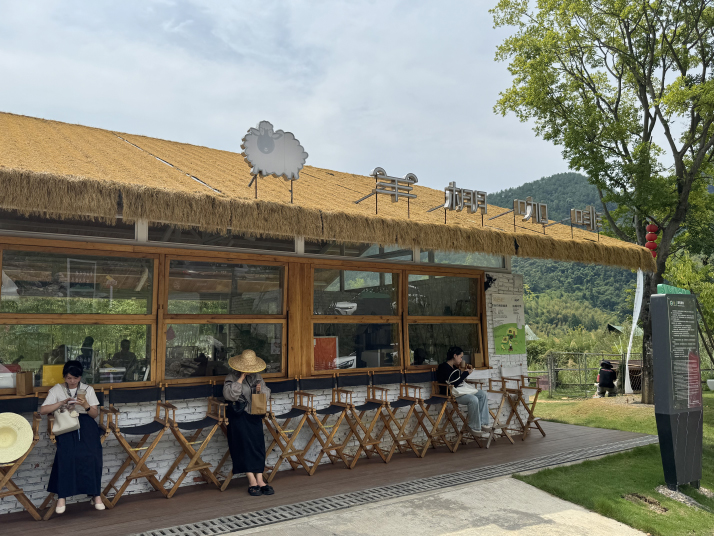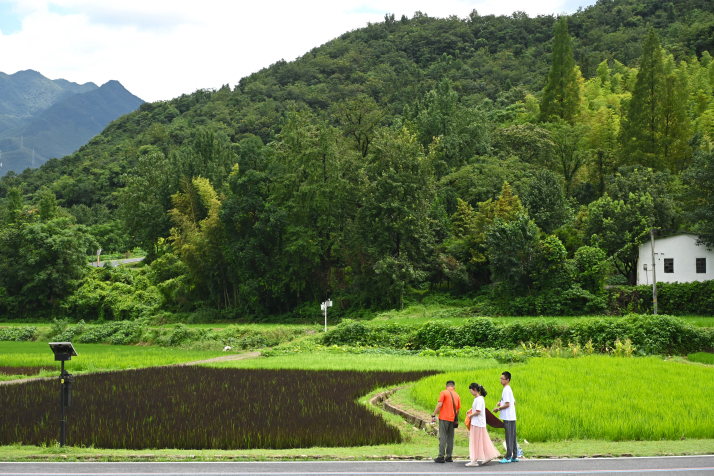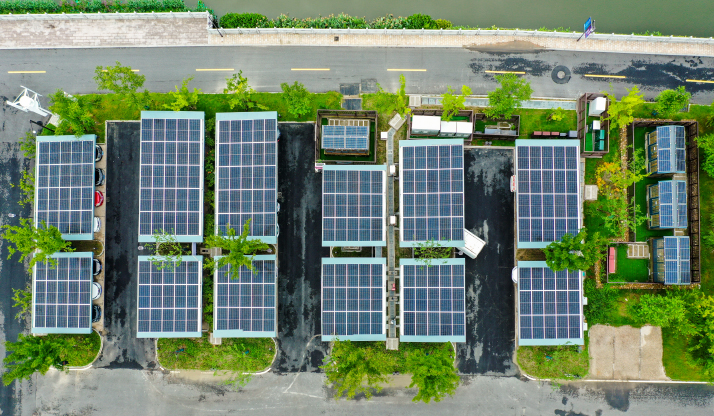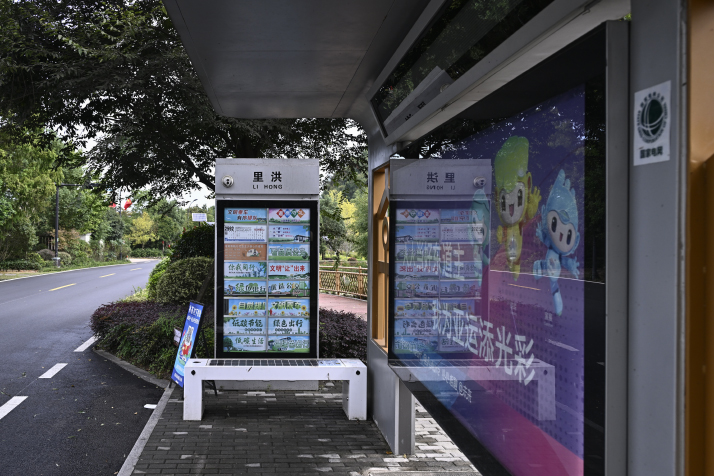| China |
| Green villages, golden opportunities | |
|
|
 An aerial view of Shanchuan Township in Anji County, Zhejiang (COURTESY PHOTO)
From a single bamboo stalk to kitchenware, furniture and even computer mouse casings, Anji, a county in the eastern province of Zhejiang, is expanding its bamboo processing industry to cut plastic use and boost local incomes. Known as the home of bamboo in China, Anji, located in Huzhou City, now boasts around 72,000 hectares of bamboo forests. Last year, its bamboo processing industries generated an annual output of over 20 billion yuan ($2.7 billion), according to local authorities. Bamboo-related industries have brought locals tangible benefits, having created around 12,000 jobs in workshops and factories as of mid-2025, with an average annual per-capita income of 85,000 yuan ($11,840). Bamboo is considered an effective carbon sink—an ecosystem, natural or artificial, that absorbs and stores more carbon dioxide from the atmosphere than it releases. With this in mind, Anji in 2021 created a trading platform that allows enterprises and farmers to redeem rewards for planting bamboo. The platform was the first of its kind established by a Chinese county. Carbon sink trading allows over 50,000 rural households in Anji to earn an additional 6,500 yuan ($904) each per year. Anji's bamboo industry illustrates Zhejiang's pursuit of both environmental sustainability and economic growth in rural areas over the past two decades. In June 2003, Zhejiang provincial authorities launched the Thousand Villages Demonstration and Ten Thousand Villages Renovation Project, also known as the Green Rural Revival Program, with the aim of renovating 10,000 administrative villages in the province and transforming 1,000 of them into models of moderate prosperity. In China, an administrative village consists of one village or several adjacent villages separated by natural divides. According to official statistics, the annual per-capita disposable income of rural residents in Zhejiang reached 42,786 yuan ($5,955) in 2024, with the urban-rural income ratio narrowing to 1.83:1 from 2.43:1 in 2003. The ratio is calculated as the per-capita disposable income of urban residents divided by that of the rural population.  Young People café transformed from an abandoned sheep shed in Lulikeng Village, Changshan County in Zhejiang Province, on August 10 (LI XIAOYANG)
Leveraging edges Chinese President Xi Jinping proposed the concept that "lucid waters and lush mountains are invaluable assets" in 2005, during a visit to Yucun Village in Anji, in his then capacity of secretary of the Zhejiang Provincial Committee of the Communist Party of China (CPC). After that, Yucun shut down industries causing severe environmental damage. Centering on the village, Anji has been driving integrated development across surrounding villages and townships, including Shanchuan Township. The area has leveraged natural resources to boost green industries like bamboo processing and eco-tourism. Nestled in Shanchuan, Skyland Resort, a subsidiary of Yunshang Tourism Group, opened to the public in July 2019 and has since become a leading destination for xianxia-themed tourism—xianxia being a Chinese fantasy genre inspired by mythology and heavily influenced by Taoism and Buddhism. Covering around 35,000 square meters, the resort welcomed almost 2 million tourist visits in 2024. In winter, Skyland transforms into a skiing haven, despite Zhejiang's typically mild climate. Snow enthusiasts from neighboring regions flock to the place when the slopes open, making it a four-season travel destination. "The resort has boosted nearby homestays—many operated by or leased from villagers," Sun Xiaodong, Chairman of Yunshang Tourism Group, told Beijing Review. According to Sun, renovated homestays can generate annual revenues of around 200,000 yuan ($27,800) for the homeowners. Shanchuan has also launched 15 sports-tourism projects. In 2024, the region received 1.8 million tourist visits, generating over 820 million yuan ($114 million) in tourism revenue—increases of 120 percent and 800 percent, respectively, compared to 2019 levels. That same year, the annual per-capita disposable income of local farmers rose to 62,900 yuan ($8,755), a 6-percent year-on-year increase.  Tourists at Yucun Village in Anji County, Huzhou City in Zhejiang, on August 6 (XINHUA)
Once renowned for its limestone industry in the 1990s, Lulikeng Village in Changshan County, has pivoted to green growth by renovating old industrial sites. Around the year 2000, the village began to gradually shut down all of its 100 lime kilns. While that decision did prompt many young residents to leave Lulikeng in search of work opportunities elsewhere, the village has experienced a revival in recent years. Today, its permanent population remains stable at around 600. Since 2021, the village has partnered with Daicunli, a local rural development firm, to leverage local resources to boost tourism. The project team transformed an abandoned sheep shed in the village into the Young People café in 2023, and turned an old limestone kiln into an oven selling freshly baked bread earlier this year. Idle-sitting farmhouses have been transformed into homestays and restaurants, and the once-barren old quarry has gotten a makeover to become a campsite. It has also launched an eatery in a natural stone cave, turning it into a hot attraction for young people seeking novel and relaxing experience. The eatery receives around 1,000 tourists per day on average during peak season. At first, the local villagers never imagined tourism would become a new economic pillar. "When we first started promoting the tourism program, some villagers were skeptical and thought that this village was too desolate to attract visitors. But now, the new businesses have gained huge popularity among young people from surrounding areas," Liu Zhiliang, Secretary of the CPC Lulikeng Village Branch, told Beijing Review. The new businesses have attracted over 50,000 tourist visits since the beginning of this year, generating revenue totaling 800,000 yuan ($111,300). Additionally, they have created over 150 local jobs, Liu said. Lulikeng native Zeng Meijun, now in her 50s, used to work outside Zhejiang. After returning to the village, she joined the Young People café. "Working here allows me to spend more time with my family," she told Beijing Review. During holidays, she pours an average 700 cups of coffee for tourists, close to the daily sales number of some cafés in big cities. "Rural tourism here has great potential. We are seeking differentiated and localized development to sustain the vitality and appeal of Lulikeng," Yu Jiafu, founder of Daicunli, said.  A parking lot covered by solar panels generating renewable energy in Meilin Village, Xiaoshan District in Hangzhou, Zhejiang (COURTESY PHOTO)
Powering the countryside Located in Xiaoshan District of Hangzhou, capital of Zhejiang, Meilin Village also follows the model presented by the Green Rural Revival Program. In the late 1990s, the village began adjusting the layout of its residential and industrial areas, making the environment more livable by improving sewage infrastructure and solid waste disposal systems, as well as upgrading roads and public restrooms. Today, Meilin thrives with booming tourism and a continuously expanding use of digital technology and clean energy. Last year, the village welcomed over 50,000 tourist visits. The village has introduced smart services, ranging from unmanned convenience stores to intelligent fitness equipment and a digital healthcare system. Thanks to this system, villagers can now receive online diagnoses and treatment for minor illnesses without having to leave their village. Getting underway in 2021, the Hangzhou unit of the State Grid Corp. of China, a state-owned electric utility company, has installed charging piles for electric vehicles in Meilin and the surrounding villages, to meet the charging demands of a growing number of tourists and local villagers. The village has also installed 25 photovoltaic (PV)-powered streetlights, reducing its annual electricity costs by 15 percent. In Meilin, rooftop PV systems power daily life and industrial operations while boosting villagers' incomes through sales of excess electricity to the power company. The PV system on the rooftop of the village's public center alone generates over 160,000 kilowatt-hours (kwh) of electricity annually, reducing carbon dioxide emissions by around 94 tons, Lai Hanbin, an engineer with the Hangzhou unit of the State Grid Corp. of China, told Beijing Review. Lai said the company has also provided consulting services for enterprises in Meilin and the surrounding villages on reducing energy consumption and advancing green transition. It has supported Ideal Packaging Group, a local company, to establish a 4.7-megawatt PV system with an annual power generation capacity of 5.5 million kwh, which can cut carbon emissions by 3,000 tons every year.  A solar-powered smart bus stop in Jingshan Village in Hangzhou, Zhejiang, in 2024 (COURTESY PHOTO)
Emerald eco-excellence With its sprawling, lush terraced tea fields, Jingshan in Hangzhou is transforming itself into a smart and green village. Villagers can now navigate using smart road signs, charge their phones wirelessly on PV-powered benches at bus stops and even exchange low-carbon activities for reward points to redeem daily essentials. In 2000, the village closed all mining operations and began reforestation efforts. Today, Jingshan's forest coverage rate has reached 96 percent. Renewable sources account for 44 percent of its total energy consumption, with annual carbon emissions cut by over 6,000 tons. As of today, 70 percent of Jingshan's 1,600 residents are involved in planting tea, frying tea leaves or promoting tea-making rituals. Last year, the local tea growing area reached over 200 hectares, with an output value of more than 50 million yuan ($7 million), according to Yu Ronghua, Secretary of the CPC Jingshan Village Branch. The village has adopted eco-friendly practices in tea cultivation and processing, reducing pesticide use and switching to sustainable packaging materials. "By scanning the QR code on Jingshan tea packages, consumers can track the carbon emissions generated during production," Yu said. Chen Yueyan, a product sales manager at the Jingshan Tourist Reception Center, explained that the center has developed a range of high-value-added tea-derived products, including tea-infused skincare lines and dim sum. With over 100 varieties, these tea-based products now generate approximately 2 million yuan ($278,300) in annual sales revenue, contributing substantially to local tea farmers' incomes. BR (Reporting from Zhejiang Province) Copyedited by Elsbeth van Paridon Comments to lixiaoyang@cicgamericas.com |
|
||||||||||||||||||||||||||||||
|